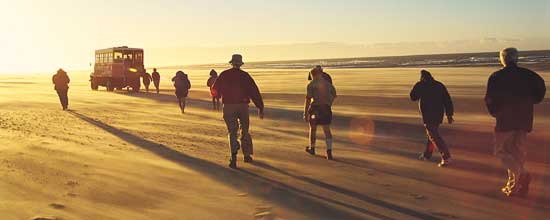

| "> |
Farewell Spit
New Zealand’s longest sandspit stretches from Fossil Point, 1.6km east of Puponga, for 35km across the entrance to GOLDEN BAY, the breakwater for a safe anchorage for shipping in all weather. The spit is formed entirely from sand, derived from the erosion of granites, schists and other rocks on the West Coast, which is transported northwards by coastal drift and is gradually filling GOLDEN BAY from the north. The spit is about 800m wide, and is built of shifting sand dunes up to 20m high (it is often possible to watch the wind "curling" the top of a live dune), patches of low scrub, marram grass and lupins, raupo swamps, and sand and mud flats 6.5 km wide that are laid bare on the south side at low tide. The Spit is one of New Zealand’s most important wading-bird habitats. Although over 100 species of birds have been recorded, the most numerous species are the godwit and knot. Towards the end of March the bar-tailed godwit (Maori - kuaka) which have been in New Zealand since mid-September, begin to move north, and then after some days of mounting excitement leave in flocks from Farewell Spit and other points around our coasts for their return journey to their northern summer breeding grounds of Arctic tundra in Siberia and Alaska. A few birds winter-over here, do not breed, but assume the colourful chestnut breeding plumage, discarding their summer feathering of light brown above and white beneath. Their long flexible beaks probe for small crustaceans, worms, molluscs, etc. in the tidal flats at low tide.
Both Cape Farewell and Farewell Spit were noted by Tasman in 1642 and named by Cook when he left New Zealand in 1770. The first lighthouse on this unusually interesting site was finished in 1870. In those days, much of the spit was invisible to ships at high tide, so one keeper, Mr Harwood, brought back two saddle bags of soil on each of his trips for supplies. The macrocarpas and pines he planted form an oasis which is conspicuous seaward and is almost as valuable as the light itself. The light is 29.5m above sea-level and its one flash every 15 seconds is visible for 24km. Despite all precautions, the Spit has claimed a number of wrecks (the last major one was the Helena in 1885), and its dunes soon swallowed the evidence. Farewell Spit is a Nature Reserve and access is restricted. Free public walking access is permitted at the base of the Spit, for a distance of 2.5km down the inner beach, or 4km down the outer beach. Access beyond here is restricted to bus trips to the Lighthouse, fishermen who must obtain a permit to fish from the outer beach, and scientific groups working on approved projects. The Spit is administrated by the Department of Conservation. One indication of the Spit’s importance as a Reserve is the fact that it is one of only three areas in New Zealand to be designated a Wetland of International Importance. Golden Bay businesses, get
listed with the Golden Bay Directory, its simple and FREE!
|
||||
Home | User
Contributions | Visitors Guide | Golden
Bay Directory
Contact gbnet | Search
the Net | gbnet Webmail
Advertising and sponsorship opportunities
© 2002 gbnet


